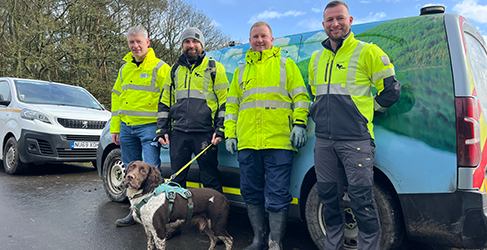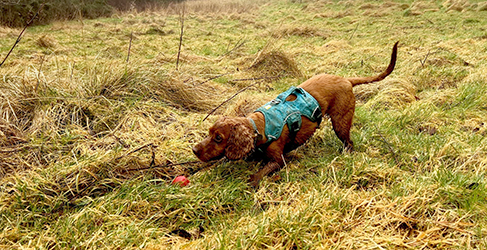Dog Detectives on the Scent of Leakage in Borders and East Lothian
17 April 2024“The dogs’ noses are an amazing tool that can be used in many different situations and we hope that the dogs can be used to help locate leaks in more parts of the rural network going forward.”
Luke Jones
MD, Cape SPC
Sniffer dogs being used to help find leaking water mains in Scotland have scored some big successes with the discovery of 21 suspected leaks in the Borders and East Lothian recently.
We've been deploying a team of specially trained dogs to help locate leaks in pipes in rural areas where the water does not always show on the surface.
Four dogs – Springer Spaniels Kilo and Denzel, Cocker Spaniel Mylo, and Tico, a Labrador Cocker Spaniel cross - have been trained by ex-military dog handlers to detect the smell of chlorine in treated water.
Scottish Water is working with Cape SPC, a company based near Warrington, England, who provide the service and own the dogs.
We are planning to utilise the dogs in some other rural parts of Scotland this year after deploying them recently in the Borders and East Lothian, using enhanced leak detection, improved training methodologies, and the integration of technologies for secondary confirmations of leakage discoveries.
The dogs found 21 ‘points of interest’ or suspected leaks in the Ettrickbridge, East Linton, Hawick, Jedburgh, and Mosstower to Hownam areas and Scottish Water repaired, or plans to repair 12 of these after the leaks were checked and confirmed.

Crack team: Dog detective Kilo with Cape SPC and Scottish Water teams

Work and play: Dog 'tec Mylo gets reward for job well done
Stewart Hamilton, a Scottish Water customer services operations team manager who has been working with Cape SPC, said: “We take our responsibility to manage water very seriously, and since 2006 leakage has been reduced by over 50% due to increased investment and pressure management.
“We use modern technology such as ground microphones, correlators, hydrophones, and other devices to pinpoint the exact location of underground assets and leaks.
“However, some bursts in rural locations are more difficult to pinpoint and we are always looking for innovative ways to do the job more effectively and to continue reducing leakage.
“That’s where these sniffer dogs come in because their sensitive noses can detect treated mains water at very low concentrations.
“When the dogs help pinpoint the exact locations of leaks we then come back to that point, investigate, excavate, and repair the bursts.”
He added: “It is often very difficult in wet, boggy terrain to source leaks, but dogs are part of the solution. We call in the team when we see an increase in flows in our data.
“It’s effective using the dogs in rural and remote areas and when the weather is wet. The handlers walk the mains, following a mains app, and the dogs are very efficient and differentiate between the smells of surface water and treated water.”
Luke Jones, managing director of Cape SPC, said: “The dogs’ noses are an amazing tool that can be used in many different situations.
“The dogs’ sense of smell is about 40 times greater than human beings’ because they have up to 300 million olfactory receptors in their noses compared with our six million. They are trained by scent association and rewarded for smelling chlorine, which rises to the surface from pipes, with ‘prizes’ of balls, toys, or treats.
“Using dogs to help people like the police and border security search for drugs and explosives is well known, but there are a host of other applications that we are exploring. We really enjoy this work with Scottish Water and we hope that the dogs can be used to help locate leaks in more parts of the rural network going forward.
“Initial trials were held a few years ago but our approach and versatility have evolved considerably and we are really pleased with these latest successes in the Borders and East Lothian and are confident of achieving more in the future.”
Scottish Water has 31,000 miles of water mains and its water supply system is very different from the majority of systems in England, reflecting the geography and topography of the country.








